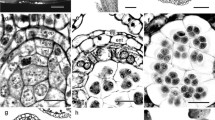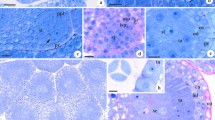Abstract
Anther and ovule development of the theaceous Ternstroemioideae is reported for the first time on the basis of eight specles of three generaAdinandra, Cleyera andEurya. Anthers of these three genera are similar and can be characterized by the following traits: tapetum of glandular type, anther dehiscing latrorse-introrse, both connective and anther epidermis heavily tanniniferous, and connective and even anther wall layers having abundant druses. Their ovules are also very similar in being bitegmic and tenuinucellate, and in having a micropyle formed by the inner integument only, three cell-layered integuments, a raphe bundle terminating at chalaza, usually amphitropous or less often campylotropous ovule, embryo sac formation of Polygonum type, ephemeral antipodal cells, and tanniniferous ovule epidermis. Such ovules are readily distinguishable from those of Camellioideae and all other families. It is suggested that the three genera studied are closely related, and that the degree of embryological specialization is highest inAdinandra and lowest inEurya. On the basis of the significant embryological discrepacies, the Ternstroemioideae seem to have diverged rather distantly from the other core-subfamily Camellioideae of the Theaceae.
Similar content being viewed by others
References
Cao, H.-J. 1965. Embryological observations onCamellia oleosa Rehd. Acta Bot. Sinica.13: 44–53. (in Chinese)
Chang, H.-T. 1981. A taxonomy of the genusCamellia. Mem. Univ. Sun Yat Sen (Nat. Sci.) No.1. (in Chinese)
Dickison, W.C. 1968. Comparative morphological studies in Dilleniaceae, III. The carpels. J. Arnold Arbor.49: 317–329.
Dickison, W.C. 1970. Comparative morphological studies in Dilleniaceae, VI. Stamens and young stem. J. Arnold Arbor.51: 403–418.
Fagerlind, F. 1939. Kritische und revidierende Untersuchungen ueber das Vorkommon desAdoxa (Lilium)-Typus. Acta Hort. Berg.13: 1–49.
Freiberg, T.E. 1983. Clethraceae.In M.S. Yakovlev, ed., Comparative Embryology of Flowering Plants, Nauka, Leningrad. (in Russian)
Howard, R.A. 1963. Clarence Emmeren Kobuski, 1900–1963. J. Arnold Arbor.44: 411–420.
Johri, B.M., Ambegaokar, K.B. andSrivastava, P.S. 1992. Comparative Embryology of Angiosperms. 2 vols, Springer-Verlag, Berlin.
Kapil, R.N. andSethi, S.B. 1963. Development of male and female gametophytes inCamellia sinensis (L.) O. Kuntze. Proc. Nat. Inst. Sci. India29-B: 567–574.
Keng, H. 1962. Comparative morphological studies in Theaceae. Univ. Calif. Publ. Bot.33: 269–384.
Kobuski, C.E. 1937. Studies in Theaceae, II.Cleyera. J. Arnold Arbor.43: 118–129.
Li, T.-Q. andCao, H.-J. 1986. Microsporogensis and development of male gametophyte ofCamellia chrysantha (Hu) Tuyama. J. Beijing Forestry Univ.2: 30–35. (in Chinese)
Liu, C.-Y. andZhang, X.-L. 1983. Development of the male and female gametophytes inCamellia reticulata L. Acta Bot. Yunnan.5: 401–407. (in Chinese)
Masamune, G. 1935. Beiträge zur Kenntnisse der Flora von Sudjapan V. Trans. Nat. Hist. Soc. Form.25: 248–251.
Mathew, C.J. 1978. Development of male and female gametophytes inCamellia sasanqua. Phytomorphology28: 262–269.
Matyunina, T.E. 1983. Theaceae.In M.S. Yakovlev, ed., Comparative Embryology of Flowering Plants, Nauka, Leningrad. (in Russian)
Merrill, E.D. 1918. Notes on the flora of Loh Fau Mountain, Kwangtung Province, China. Philipp. J. Sci.13-C: 123–161.
Metcalfe, C.R. andChalk, L. (eds.) 1983. Anatomy of the Dicotyledons, Second Edition. vol. 2, Clarendon Press, Oxford.
Rao, A.N. 1957. The embryology ofHypericum patulum Thunb. andH. mysorense Heyne. Phytomorphology7: 36–45.
Sethi, S.B. 1965. Structure and development of seed inCamellia sinensis (L.) O. Kuntze. Proc. Nat. Inst. Sci. India31-B: 24–33.
Sporne, K.R. 1975. A note on ellagitannins as indicators of evolutionary status in Dicotyledons. New Phytol.75: 613–618.
Swamy, B.G.L. 1948. A contribution to the embryology of the Marcgraviaceae. Amer. J. Bot.35: 628–633.
Tsou, C.-H. 1994. The Embryology, Reproductive Morphology, and Systematics of Lecythidaceae. Mem. New York Bot. Gard. Vol.71, New York.
Weitzman, A. 1987. Systematics ofFreziera Willd. (Theaceae). Ph.D. Dissertation, Harvard Univ., Cambridge, MA, USA.
Yang, S.-X. 1994. Studies on the systematic position of generaPyrenaria, Tutcheria andParapyrenaria of family Theaceae. Acta Bot. Ynnan. (in Chinese, in press)
Author information
Authors and Affiliations
Rights and permissions
About this article
Cite this article
Tsou, CH. Embryology of theaceae — Anther and ovule development ofAdinandra, Cleyera andEurya . J. Plant Res. 108, 77–86 (1995). https://doi.org/10.1007/BF02344309
Received:
Accepted:
Issue Date:
DOI: https://doi.org/10.1007/BF02344309




